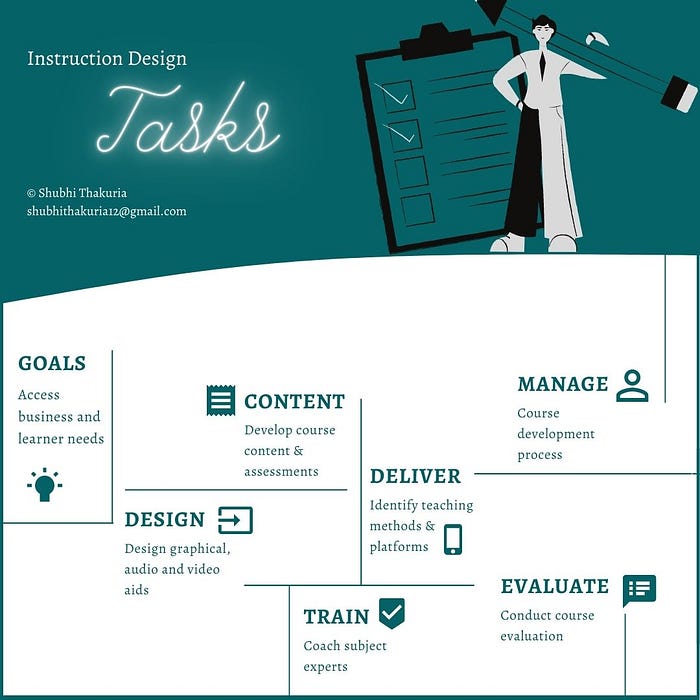Who are Instructional Designers?
- 11/03/2022
- elearning
The field of eLearning is becoming widely recognized, there are still questions about what people within eLearning do. My position has always been a mystery – and it’s perfectly fine when people ask me what I do! I don’t expect anyone to know this, as I don’t know many other job names and responsibilities. However, now that we are going through an influx of „courses” (i.e. a bunch of recorder videos with occasional links to articles all over the internet) made by people who have little experience is learning or pedagogy, I feel it’s super important to explain who usually stands behind a good quality eLearning course.
WHAT IS INSTRUCTIONAL DESIGN?
In a nutshell, instructional design is a process of taking information, analyzing it in a given, specific context, and then shaping them in a way that makes it interesting, easy, and engaging for learners to understand and apply.
This process is based on an Instructional Design model (there are a few popular ones circulating around, most prominently the ADDIE model), where the information undergoes reshaping and reframing according to learning strategies, pedagogy, target group, etc.
The history of Instructional Design, and eLearning in general, dates back to the 1940s, when „training programs were developed during World War II. The US Air Force produced hundreds of training films and filmstrips marking the initiation of technology for educational and training purposes. Over the course of the 1950s and 60s, methodologies for instructional learning material continually evolved and the „Instruction Design Model” was conceived in 1965 by Robert Gagné; the model, also known as „Nine Events of Instruction”, continues to be relied on as guidance to create a broad framework for eLearning.” If you’re interested, here’s a handy infographic with more dates and events in the history of ID.
The fundamental purpose of Instructional Design is to identify the skills, knowledge and the attitude gaps of a targeted audience and to create, select and suggest learning experiences that close this gap.
Learning Experience Design Consultant, eLearning Coach
WHAT DOES AN INSTRUCTIONAL DESIGNER DO?
Depending on different (company) environment, the tasks of an Instructional Designer can vary. However, there are a few substantive elements that all IDs should share: the knowledge of how people learn and how to frame information to reach them. Apart from that, the day-to-day tasks can include:
- Analyze training needs of a group or individual (using correct methods) – this includes managing people, creating presentations for „bosses” or trying to convince people that such and such topic should be covered by coaching, not a course.
- Analyze target audience and identify learner profiles – by various methods of research make sure that it’s clear who will do the course, and why.
- Define learning goal and objectives – to make sure that everyone knows the reasons for the course, and knows what they can gain.
- Identify the appropriate learning strategy – knowing the above and elements of pedagogy, find the best mediums and tools to present the knowledge.
- Write, rewrite, edit, and format text content – according to learning objectives and target group.
- Create graphics, videos, or other multimedia to support the learning acquisition.
- Know the differences between evaluation and assessment, and create such, according to best learning strategies.
- Put all of the above together in authoring tools, online, and manage the learners and their progress.
WHY IS INSTRUCTIONAL DESIGN IMPORTANT?
There are countless benefits of having an ID in your team, not only in an eLearning team, but many times as an addition in marketing teams, communication teams, or even as business consultants. Here are some benefits of having an Instructional Designer in your corner:
ID Can Analyze the Target Group
Content is never a one size fits all product. It’s important to know who the learning course is designed for, so correct instructional strategies can be applied, so ID can match methods and exercises to the audience. The same for any communication – if you want to reach someone, speak their language. ID can help find that language and craft messages that are concise, appealing, and engaging for the receiver!
ID Makes Learning Engaging
Even though we can tell someone how to make toast, it doesn’t mean we’re doing it in the best form and in a way they can easily apply. „ID focuses on the learner’s experience, and on how to make it stimulating, memorable, and true-to-life.” And in today’s world, crafting instructions and information in a way that is easy to grasp, engaging, and straightforward is quite the gift!
ID Makes Learning Efficient
Even though information is one click away, it doesn’t mean it’s we learn things when we click on them. Learning is a process that happens in a certain way, depending on conditions. ID can sift through the information, make sure the important elements are saved, organize them and serve them to you in a form that speaks to you the most!
If you wish to explore the exact reasons why Instructional Design is important, please read:
- Tom Kuhlmann’s article „What Everybody Ought to Know About Instructional Design” (Tom is an eLearning professional with over 20 years of hands-on experience),
- or the piece „5 Main Reasons Why Instructional Design Matters In eLearning” by Naveen Neelakandan from eLearning Industry.
- And if you’re super-interested, you can watch this marvelous video about „Why we need instructional design more than ever” by Allison Rossett, from Learning Technologies Conference 2013. Brilliant info!

Copyright © 2017-current Gosia Pytel. All rights reserved
Terms and Conditions | Privacy and Cookie Policy || secretcats.pl🧡tworzenie stron internetowych
